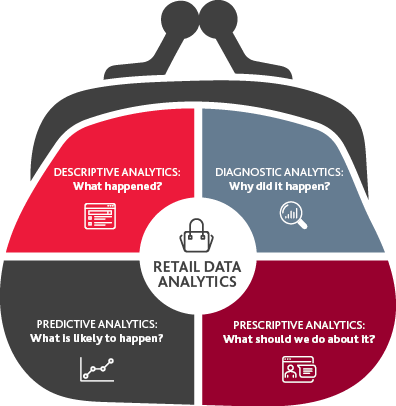
,
Most retailers today use technology to capture data. Over the past few years, customers got use to a seamless digital experience and the pandemic forced retailers to reconsider how they were reaching their customers which resulted in digital growth. From digital growth came website optimisation, increased personalisation, frictionless checkout and returns, and in some instances better customer experiences. This has created an entirely new set of expectations. Consumers are now holding brands to a much higher standard because they embraced our increasingly connected digital world and realised how much better it made their shopping experience.
Businesses today have access to more data than ever, providing valuable opportunities to those who understand how to make use of it. When it comes to serving customers, data can help pinpoint needs, but it must be analysed thoughtfully.
As authored in Quantzig, Four Types of Retail Analytics Shaping the Retail Industry, “Data analytics can help retailers understand customer behaviour by analysing massive data sets regarding their information and transaction history. Emerging technologies such as radio frequency identification (RFID) tags, QR codes, and near-field communication (NFC) technology enable retailers to effectively guide the customers in their journey from the store to make a purchase.”
Retailers can get insights about their customers based on the type of retail data analytics used.

The use of analytics creates an opportunity to collect, analyse and operationalise customer’s data to transform retail operations. Here’s some ways analytics can help retailers to:
Attract and retain customers:
The buyer journey has changed – potential customers are now researching, reading reviews, checking social media, and narrowing choices before even speaking to a salesperson, blurring the lines between the traditional domains of marketing and sales. While the digital world can potentially expand your audience, the challenge lies in creating marketing programs that engage the right prospects so you can easily measure response rates, pipeline velocity, and trends. Leveraging data from these touchpoints is a valuable opportunity for collecting information at the early stages of the customer journey.
Create hyper-personalised experiences:
Offering hyper-personalised experiences means going above and beyond to understand your customers’ needs and desires. Today’s customers want to engage with brands that can instantly identify them, have immediate access to information about every interaction on every channel and understand their issue and how to solve it. Hyper-personalisation is the most advanced way brands can tailor their marketing to individual customers. It’s done by creating custom and targeted experiences through the use of data, analytics, AI, and automation. As digital marketing becomes more competitive, hyper-personalised marketing provides the opportunity for retailers to meaningfully engage customers, deepen existing relationships and build new ones, and improve the customer experience. Implementing this type of strategy not only increases customer satisfaction but also drives brand loyalty, willingness to spend, and overall marketing effectiveness.
Anticipate supply chain disruption:
Retailers can use data analytics to closely monitor disruptive events as they unfold, assess their potential impact on the business, and make strategic decisions about how to mitigate the effects of disruption. With supply chain disruptions still present, leveraging data and IT systems that can give customer insights will provide a competitive edge to retailers.
How BDO can help
BDO Australia’s retail experts specialise in data analytics and have the relevant industry experience to help. Even in these uncertain times, opportunities for optimisation are plentiful. For more information, please get in touch with our team. We can help you with:
- Customer relationship management
- Data management and analytics
- Pricing analytics.
Visit www.bdo.com.au for information and professional advice.
Article source can be found here.

